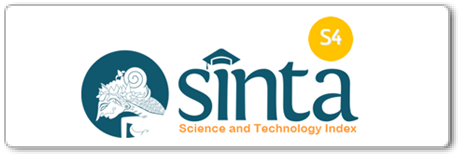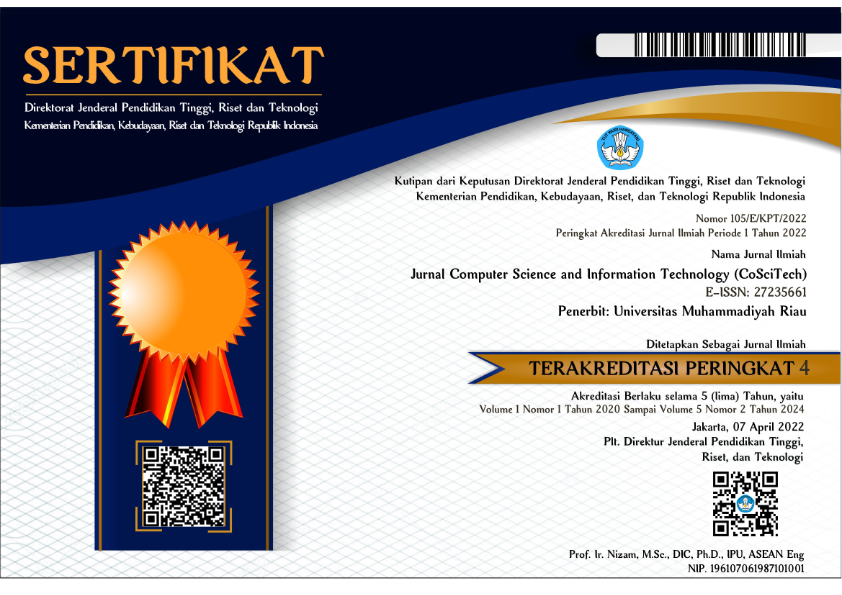Smart Technology of CO2 Monitoring as Prevention of Acute Respiratory Infection Disease Using Artificial Intelligence Algorithm
DOI:
 https://doi.org/10.37859/coscitech.v5i3.7709
https://doi.org/10.37859/coscitech.v5i3.7709
Abstract
Air pollution is a serious environmental problem that can affect human health because it contains toxic gases, one of which is carbon dioxide (CO2). This toxic gas can cause Acute Respiratory Infection (ARI). ARI is an acute infection of the respiratory tract that can cause death. One effort to prevent ARI is to monitor CO2 gas as a trigger for ARI. This study develops intelligent technology for monitoring CO2 concentration using a rule-based artificial intelligence algorithm by utilizing Internet of Things technology integrated with telegrams to provide warnings. Rule-based systems are part of artificial intelligence that have advantages and limitations that need to be considered before deciding whether it is the right technique to use in solving existing problems. This study uses daily data taken by CO2 gas sensors from 07.00 - 16.15 WIB with a data collection range of 15 minutes with a total of 38 data samples taken. The results of the study show that this rule-based algorithm is able to classify CO2 concentrations according to the rules that have been made. In addition, from the data taken, 42% are in the safe category, 50% are in the alert category and 8% are in the danger category, each of which has an effect on health. The system that was built can also send danger notifications via telegram
Downloads
References
[2] E. Kusumaningrum, H. B. Hermawan, Sumarsono, and D. Hariyadi, “Analisis kualitas udara menggunakan internet of things di pintu perlintasan kereta api,” J. CoSciTech (Computer Sci. Inf. Technol., vol. 4, no. 3, pp. 574–579, 2023, doi: 10.37859/coscitech.v4i3.6219.
[3] Y. Aprianto, N. Nurhasanah, and I. Sanubary, “Prediksi Kadar Particulate Matter (PM10) untuk Pemantauan Kualitas Udara Menggunakan Jaringan Syaraf Tiruan Studi Kasus Kota Pontianak,” Positron, vol. 8, no. 1, p. 15, 2018, doi: 10.26418/positron.v8i1.25470.
[4] W. Wu et al., “Quantifying China’s iron and steel industry’s CO2 emissions and environmental health burdens: A pathway to sustainable transformation,” Environ. Sci. Ecotechnology, vol. 20, p. 100367, 2024, doi: 10.1016/j.ese.2023.100367.
[5] A. R. Perdana, A. Indiani Pangastuti, and Y. Donni Haryanto, “ANALISIS KONSENTRASI PM10 dan PM2.5 PADA TITIK PEMANTAUAN BUNDARAN HI JAKARTA PUSAT PERI- ODE DATA FEBRUARI-OKTOBER 2021,” J. Samudra Geogr., vol. 6, no. 1, pp. 1–8, 2023, doi: 10.33059/jsg.v6i1.7158.
[6] N. R. Martins and G. Carrilho da Graça, “Health effects of PM2.5 emissions from woodstoves and fireplaces in living spaces,” J. Build. Eng., vol. 79, no. June, p. 107848, 2023, doi: 10.1016/j.jobe.2023.107848.
[7] T. Ha Manh, M. Le Thi Ai, A. Nguyen Tuan, and T. Le Viet, “Knowledge, attitudes and practices of mothers during care of children with acute respiratory infections under 5 years old,” Int. J. Africa Nurs. Sci., vol. 19, no. July, p. 100613, 2023, doi: 10.1016/j.ijans.2023.100613.
[8] R. Rakholia, Q. Le, K. Vu, B. Q. Ho, and R. S. Carbajo, “AI-based air quality PM2.5 forecasting models for developing countries: A case study of Ho Chi Minh City, Vietnam,” Urban Clim., vol. 46, no. October, p. 101315, 2022, doi: 10.1016/j.uclim.2022.101315.
[9] V. V Rambing et al., “Literature Review: Gambaran Risiko Kesehatan pada Masyarakat akibat Paparan Gas Karbon Monoksida (CO),” Kesmas, vol. 11, no. 4, pp. 95–101, 2022.
[10] N. Susanto, “Faktor Lingkungan Sebagai Prediksi Infeksi Saluran Pernafasan Akut di Wilayah Bencana Gunung Berapi,” J. Ilmu Kesehat. Masy., vol. 10, no. 04, pp. 269–276, 2021, doi: 10.33221/jikm.v10i04.940.
[11] T. H. Chang et al., “Clinical characteristics of hospitalized children with community-acquired pneumonia and respiratory infections: Using machine learning approaches to support pathogen prediction at admission,” J. Microbiol. Immunol. Infect., vol. 56, no. 4, pp. 772–781, 2023, doi: 10.1016/j.jmii.2023.04.011.
[12] Y. Jang et al., “Assessing the impact of climate and air quality policies on future emissions in Korea through quantification of control and co-control effects,” Atmos. Pollut. Res., vol. 15, no. 1, p. 101952, 2024, doi: 10.1016/j.apr.2023.101952.
[13] E. Pisoni et al., “Modelling the air quality benefits of EU climate mitigation policies using two different PM2.5-related health impact methodologies,” Environ. Int., vol. 172, no. January, p. 107760, 2023, doi: 10.1016/j.envint.2023.107760.
[14] Fajar Rohman Hariri, “Penerapan Metode Fuzzy Sugeno Dalam Pendaftaran Siswa Baru di SDN Sonopatik 1 Nganjuk,” Tek. Inform. Univ. Nusant. PGRI Kediri, vol. 3, no. 1, pp. 41–46, 2016, [Online]. Available: Penerapan Metode Fuzzy Sugeno Dalam Pendaftaran Siswa Baru di SDN Sonopatik 1 Nganjuk
[15] A. Amsar, K. Khairuman, and M. Marlina, “Perancangan Alat Pendeteksi Co2 Menggunakan Sensor Mq-2 Berbasis Internet of Thing,” METHOMIKA J. Manaj. Inform. dan Komputerisasi Akunt., vol. 4, no. 1, pp. 73–79, 2020, doi: 10.46880/jmika.vol4no1.pp73-79.
[16] A. Sulistiyo and D. Suryono, “Wireless Sensor System Untuk Monitoring Konsentrasi Debu Menggunakan Algoritma Rule Based,” Youngster Phys. J., vol. 5, no. 2, pp. 43–50, 2016.













